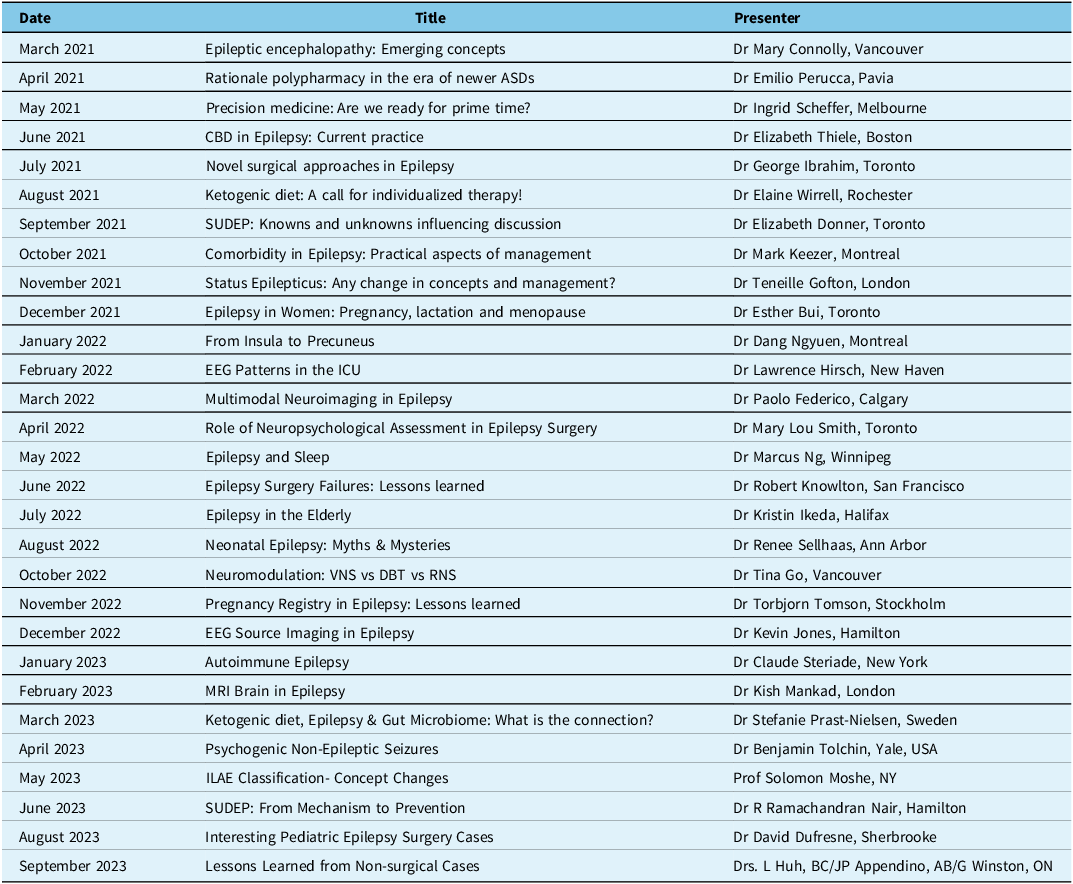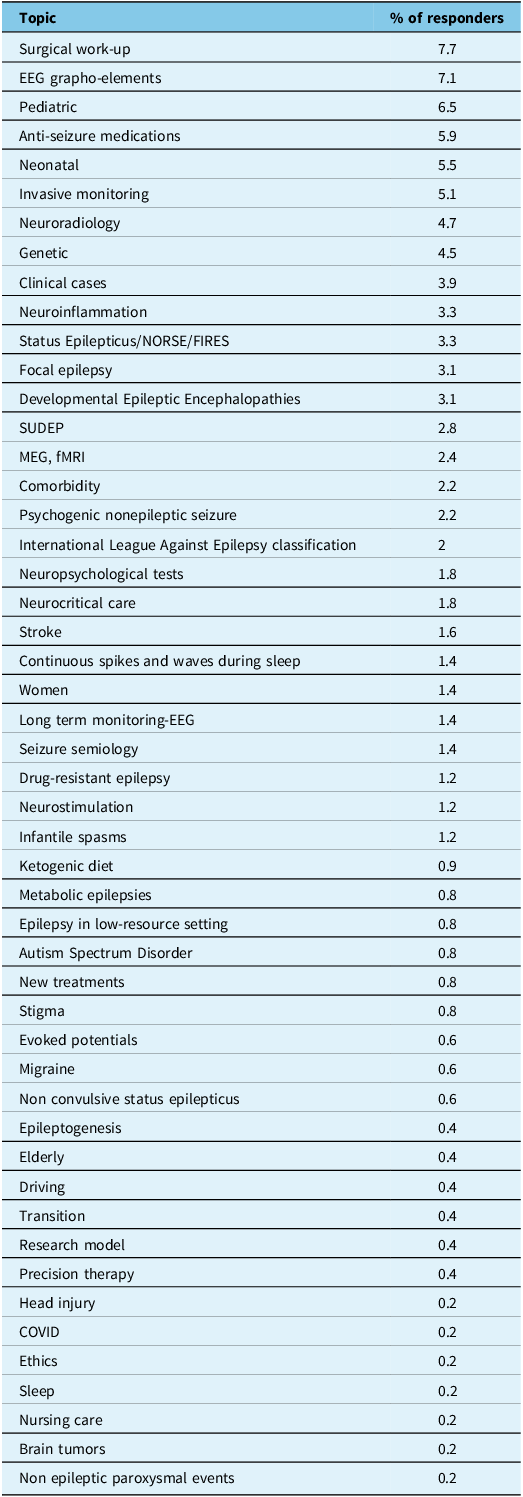The objective of the International League Against Epilepsy (ILAE) is to guarantee that stakeholders worldwide, including but not limited to healthcare professionals, patients and their caregivers, policy makers, and the public, have access to the necessary educational and research materials to comprehend, diagnose, and provide care for individuals living with epilepsy. Reference Blümcke, Arzimanoglou and Beniczky1 To achieve this goal, a proficiency-based curriculum has been designed for epileptologists to cover expected learning objectives divided into seven domains of competencies and three levels of proficiency. Reference Blümcke, Arzimanoglou and Beniczky1 Several teaching initiatives have been established to address these educational needs. Most of them involve the utilization of online, distance-learning platforms; Reference Beniczky, Blümcke, Rampp, Shisler, Biesel and Wiebe2,Reference Blümcke, Biesel and Bedenlier3 although, these are not free of charge.
Herein, we report our experience, with the goal to inspire other groups in neurology, on how to develop and hold an inclusive, equitable, and free-of-charge educational space with a worldwide reach.
How we did it
Further fueled by the needs to create inclusive learning opportunities during Covid-19 pandemic, in early 2021, the Canadian League Against Epilepsy (CLAE) launched a free-of-charge accredited virtual continuous education program in epilepsy under the direction of the Canadian Epilepsy Teaching Network (CETN). The CETN is composed of CLAE members, including the director of education, and embraces pediatric and adult epileptologists and neurophysiologists, with a wide range of interests within epilepsy education. Monthly virtual rounds, given by national and international experts, were offered. These targeted healthcare professionals involved in or working with epilepsy.
Since March 2021, monthly webinars have been held on the virtual platform Zoom©. The invitations were open and free of charge. The link to participate was regularly posted on the CLAE website (https://claegroup.org/CETN-Program) and sent via email to all registered members. The topics were initially selected based on the ILAE curriculum Reference Blümcke, Arzimanoglou and Beniczky1 and, starting from the second year, tailored to the audience’s expressed interests. National and international experts were chosen through internal discussions within the CETN. Each webinar had a duration of 60 minutes, with at least 10 minutes reserved for an interactive “question and answer” session with the audience via the chat. Every webinar was recorded and shared on the CLAE website, if consented by the presenter. The list of all the topics and their respective presenters is shown in Table 1.
Table 1. Monthly webinars presented by Canadian Epilepsy Teaching Network from 2021 to September 2023

AB = Alberta; ASDs = anti-seizure drugs; BC = British Columbia; CBD = cannabidiol; DBT = deep brain stimulation; EEG = electroencephalography; ICU = intensive care unit; ILAE = International League Against Epilepsy; MRI = magnetic resonance imaging; ON = Ontario; RNS = responsive neurostimulation; SUDEP = sudden unexpected death in epilepsy; VNS = vagus nerve stimulation.
At the end of each meeting, a survey questionnaire (performed using Google Forms©) was sent to the participants. The meeting organizers provided the link in the Zoom© meeting’s chat. In the initial part of the survey, participants were required to identify their role (physicians, trainees, basic scientists, nurses, etc.) and specify whether they were first-time attendees or returning participants to the CETN rounds. Since May 2023, attendees were asked to document the current country of practice. Afterward, participants were asked to rate their satisfaction on a 5-point Likert scale (from 1 for “strongly disagree” to 5 for “strongly agree”) regarding the content, the presentation format, and the overall presenter’s performance and the CETN program. The concluding part of the survey included gathering open-ended comments regarding the impact of the session on participants' knowledge and clinical practice, suggestions for future webinar topics, and any feedback to improve the program. Participants who completed the survey were identified as “responders”. Responders were entitled to receive a certificate of participation by email with continuing medical education credits.
What we found
A total of 29 webinars were conducted from March 2021 to September 2023. A median of 118 [25th percentile: 112–75th percentile: 134] participants (responders and non-responders) were recorded to have connected to the Zoom© platform during the monthly webinars. Of these, a median of 46 [34–51] responders completed the survey. They were mostly physicians (58.9%) or trainees (22.8%). Basic scientists accounted for 2.2% of the total, nurses for 2.4%, while 13.7% identified themselves as another type of professional. The average rate of returning registrants was 82%. Since May 2023, international responders’ country of practice was also recorded (Fig. 1).

Figure 1. Country of practice of those who attended the Canadian Epilepsy Teaching Network monthly rounds held between May 2023–September 2023 and who responded to the survey.
Responders rated the quality of the webinar content very positively. In particular, the median scores were 4.71 [4.64–4.78] for attainment of learning objectives, 4.68 [4.63–4.76] for knowledge enhancement, 4.67 [4.61–4.78] for meeting expectations, and 4.53 [4.47–4.64] for provision of relevant information in clinical practice (Fig. 2).

Figure 2. Results from the satisfaction questionnaire answered by responders.
Regarding the presentation format and conveyed information, median scores were 4.79 [4.74–4.83] for being free from commercial bias, 4.76 [4.68–4.78] for content relevance, 4.67 [4.56–4.76] for using effective teaching methods, and 4.59 [4.46–4.63] for allocation of adequate time to discussion.
The main areas in which responders reported feeling significantly improved were therapeutic (26.8%) and diagnostic (22.3%) management of their patients. In addition, they showed increased confidence in the pre-surgical work-up (9.2%), as well as a better understanding of genetic etiologies (6.5%). Other major areas of improvement were identified in the management of the transition from paediatric to adult (6%), in the definition and classification of epileptic syndromes (5.6%), as well as in handling anti-seizure medications (ASMs) (5%). The remainder answers individually accounted for less than 5%, for a total of 18.6%.
In Table 2, the main topics requested-suggested by the responders for the upcoming webinars are listed. The top ten suggested topics were: surgical work-up (7.7%), EEG grapho-elements (7.1%), pediatric epilepsies (6.5%), pharmacology of ASMs (5.9%), neonatal epilepsies (5.5%), invasive monitoring (5.1%), neuroradiology (4.7%), genetic epilepsies (4.5%), clinical cases (3.9%), neuroinflammation (3.3%). As observed in Table 1, 100% of the presented topics starting from the second year were chosen based on the desires and needs expressed by the audience.
Table 2. Suggested topics by the responders during Canadian Epilepsy Teaching Network monthly rounds

EEG = electroencephalography; FIRES = Febrile infection-related epilepsy syndrome; fMRI = functional magnetic resonance imaging; MEG = magnetoencephalography; NORSE = new-onset refractory status epilepticus; SUDEP = sudden unexpected death in epilepsy.
We also collected suggestions to improve our sessions. Most responders requested increased interaction during the webinars (i.e. live polls, open Q&A, enabling microphones) (59.6%), the option for offline access to educational materials after the session (19.2%), and a major utilization of clinical cases (13.1%). Additionally, there were suggestions for incorporating more videos (3.5%) or clinical synopses at the end of the webinar (1.7%). Respectively 1.7 and 1% advised improved organization of the webinars and focusing on topics of greater clinical relevance.
What we learned
There is a dearth of research in the medical field when it comes to “Epilepsy Education”, and it is uncommon to find publications discussing initiatives in this area in scientific journals. Reference Braga, Mifsud and D’Souza4 An increase in such educational initiatives and subsequent literature has been observed with the outbreak of the pandemic, with a net rise in the use of virtual strategies estimated to be between 300% and over 3000%. Reference Weisshardt, Vlaev and Cross5 The application of surveys is a commonly used methodology in the field of epilepsy, both to measure patient satisfaction with the treatments received and to evaluate the quality of education programs targeted to patients and healthcare personnel. Reference Chemaly, Kuchenbuch and Teng6,Reference Kuchenbuch, D'Onofrio and Wirrell7
One of the main advantages of technology is the possibility to simultaneously connect regions of the globe that are far apart from each other. This tool could enable the development of an education that is inclusive and equitable and spanning across different domains, promoting equal opportunities for all. Reference Shlobin, Radwanski and Sandhu8,Reference Martínez-Juárez, Del Carmen Garcia and Camilo-Cotuá9 Low- and low-to-middle-income countries lack epilepsy specialists, and often primary healthcare providers take care directly of people with epilepsy. Reference Singh, Braga and Carrizosa10 It is, therefore, crucial that the enormous strides in knowledge about epilepsy made in recent years can also be disseminated to obtain a tangible improvement in the care of people with epilepsy worldwide. We believe our program reflects such spirit as shown in the long list of countries that have accessed to the seminars (Fig. 1). Other fee-based international platforms for e-learning exist; however, the access cost may limit the much-needed learning from some regions in the Globe making the Canadian offer quite unique for those learners from limited resources regions.
A recent meta-analysis argued that acquiring knowledge through reading a physical paper text leads to a deeper understanding compared to reading a virtual text. Reference Altamura, Vargas and Salmerón11 While current virtual communication platforms allow for a high simulation of a conference, the potential for face-to-face interaction is probably not attainable, and future studies will need to evaluate this aspect.
Our program was free and open to anyone who expressed an interest in epilepsy, regardless of their role. Most attendees were physicians or trainees, but allied healthcare providers also participated. Through their survey responses, we unexpectedly learned about their interest in clinical cases-based topics; therefore, these were considered and incorporated as the next iterations of the program during the second year where more clinical cases and Q&A interactions were included. This approach was aimed to support our educational philosophy of inclusion and equity.
Unfortunately, the data reflects the responses provided by almost half of the participants who answered the survey. We can speculate that most of those who completed the survey may be Canadian, as completing the survey was a necessary requirement for obtaining continuing medical education credits. Despite knowing this limitation, as mentioned above, we know that there are colleagues from countries other than Canada attending and responding to the feedback forms confirming the broad reach of these seminars.
We also learned during this project that including a self-assessment section on the knowledge acquired following a seminar may be a logical next step. This will allow an objective assessment of the role of the seminar and its impact of the imparted content in the knowledge consolidation of the attendee. In addition, this can further provide information to the CETN webinars organizers on the background knowledge of the audience and where to emphasize further educational efforts.
Consistently, almost 20% of the audience was comprised of first-time attendees, suggesting our educational activity sparked interest in the field of epilepsy and is perhaps attracting future leaders to the area. The second year of the program compiled the attendees’ request which seemed to have appealed to the broader audience as it shows a high level of appreciation, a high level of returning learners and a high rate of willingness to recommend our sessions.
To conclude, the CETN group, is extremely curious about assessing the educational impact of utilizing more clinical cases and educational videos, exploring the potential for live interaction during sessions via both chat and webcam/microphone, and implementing self-assessment measures before and after sessions, as suggested by our audience. These improvements are to be included in our seminars as future steps.
Acknowledgements
We gratefully acknowledge all speakers and participants.
Author contributions
TAF and JPA co-conceived and supervised the development of the study. GDO interpreted the data and wrote the first draft of the manuscript. All the authors have critically revised the final version of the manuscript.
Funding statement
None.
Competing interests
None.





